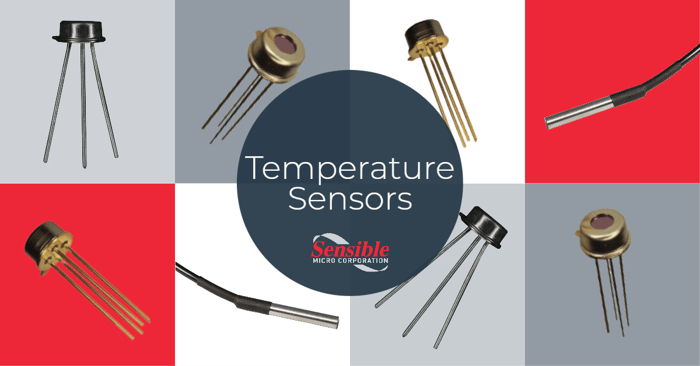While a lot of electronic components and devices are being negatively affected by the current COVID-19 pandemic, some parts are in high demand and growing in market profitability, such as temperature sensors.
Because one of the primary symptoms of COVID-19 is a high fever, sales of temperature measurement and monitoring devices have skyrocketed, with thermometers sales being up by 498% This has contributed to the higher demand on electronic component supply chains. Reported last month, the size of the global temperature sensor market is projected to grow from $6.3B USD in 2020 to almost $9B USD by 2027. This forecasted industry growth is a result of growing demand for temperature sensors in many different industry sectors, such as automotive sector, consumer tech and industrial automation. With the recent and unexpected increase in need for temperature sensors in advanced and portable healthcare equipment, the temperature sensor market might experience even more growth.
More specifically, contact type temperature sensors are expected to account for a larger share of the temperature sensor industry during the forecasted seven year period. This is because contact temperature sensors are widely used in multiple industries, such as consumer electronics, energy, power, automotive and medical, with medical being the most topical.
The digital output segment within the temperature sensor industry is projected to hold a bigger share of the market during the forecast period. Temperature sensors that have a digital output are more popular than those with an analog output because they are better suited for remote applications, used in aerospace, industrial automation and, of course, medical applications.
While temperature sensors are largely being diverted to medical and other related applications presently, they have multiple use cases- more than just the assumed thermometer. Below we lay out the basics and must-knows of temperature sensors.
About temperature sensors:
Temperature sensors are what they sound like- they are sensors used to detect or ‘sense’ the temperature of an item. Temperature Sensors are used to measure the amount of heat energy that is generated by an object or a system. They can also be used to detect how cold something is. These sensors can detect any physical change in temperature and produce either an analog or digital output. Temperature sensors are the most commonly used type of sensors and are in a menagerie of devices and products.
Types of temperature sensors:
A temperature sensor consists of two basic physical types:
- Contact Temperature Sensor Types: Have to be in physical contact with an object to detect changes in temperature.
- Non-contact Temperature Sensor Types: Do not have to be in physical contact with an object. Instead, they use radiation and convection to detect changes in temperature.
These two basic types of temperature sensors can further be subdivided, usually falling into the three categories below.
1. Thermistor: The name Thermistor is a combination of words, meaning thermally sensitive resistor. Thermistors change physical resistance when subjected to changes in temperature.
2. Resistive Temperature Detectors (RTD): A popular type of electrical resistance temperature sensor. They are precision temperature sensors, made from high-purity conducting metals. RTDs electrical resistance changes as a function of temperature, similar to that of a thermistor.
3. Thermocouple: The most commonly used type of temperature sensors and one of the oldest ways to measure temperature digitally. Thermocouples are popular because of their simplicity, small size and the speed of response to changes in temperature. Thermocouples have the widest temperature range of all the temperature sensors.
Type Comparison:
No one type of temperature sensor is perfect for all applications because of the sensors’ wide variety. Below is a general comparison of the three main types.
|
Type: |
Measurement Accuracy: |
Cost: |
Range: |
Resolution: |
Robustness: |
|
Thermistor |
Low to Medium |
Low |
-80°C to +150°C |
High |
Low |
|
RTD |
High |
Medium to High |
-200°C to +600°C |
Medium |
High |
|
Thermocouple |
Medium |
Low |
-200°C to +1200°C |
Low |
High |
What are temperature sensors used for?
Temperature sensors are used just about everywhere, from household items and medical devices to automotive devices and industrial machinery. Some applications include, but not limited to:
- Oil drill bits
- Automotive radiators
- Battery chargers
- Medical thermometer (contact and non-contact, IE oral and infrared scanner)
- Household Thermostats
Key Manufacturers:
Though many brands make temperature sensors, some of the key manufacturers are:
- ABB
- Analog Devices Inc.
- Delphi Automotive
- Siemens AG
- Freescale Semiconductors
- Honeywell
- Texas Instruments
- NXP Semiconductors
- Panasonic Inc.
Sourcing temperature sensors:
With thermometers currently in high demand, temperature sensors may become harder to source and have longer lead times. As a certified electronic component distributor to thousands of companies globally, Sensible Micro has the ability to source a wide variety of electronic components, including all types of sensors. Additionally, we can provide our customers with scheduling packages and customized stocking. Schedule a call with one of our sourcing experts today to discuss your temperature sensor needs.
Stay on top of the latest developments in the industry and in our community by subscribing to the Sensible Micro blog.



















